Three-Dimensional Stereophotogrammetry Facial Morphologic Signatures of Temporomandibular Disorders
Abstract
Aim
To utilize stereophotogrammetry to investigate changes in three-dimensional (3D) facial morphology in both TMD-free individuals and TMD patients, both before and after treatment, and to classify subjects as either TMD-free or TMD patients.
Methods
40 participants (TMD and TMD-free, mean age of 38.9 ± 15.3 years) were recruited from the Oral Medicine Clinic at the Faculty of Dentistry, University of Otago. Participants were given a questionnaire, and 3D images of their faces at maximum mouth opening and in occlusion were recorded using the 3dMDtrio craniofacial scanner. Participants were followed up after 3 months and 6 months. The 3D images captured were analysed using the 3dMD Vultus software.
Results
Significant changes were observed between baseline and 3-month follow-up measurements in TRAR-GoR(C), GoR-GN(C) and LS-PG(O) (p < 0.05). At the 6-month follow-up, additional significant differences were found in G-PG(R), TRAL-SN(C), TRAR-GoR(C), GoR-GN(C), LS-PG(O), and maximum mouth opening (MMO) (p < 0.05). TRAR-GoR(C), LS-PG(O), TRAL-GoL(C), MMO, and TRAR-SN(C) exhibited significant correlations. LS-PG(R) was the most reliable predictor. Discriminant analysis revealed an 85% sensitivity and 90% specificity in classifying individuals with and without TMD.
Conclusion
Significant 3D morphological changes were detected in TMD patients' post-treatment, with notable mouth opening and masseter muscle volume reduction.


 求助内容:
求助内容: 应助结果提醒方式:
应助结果提醒方式:


